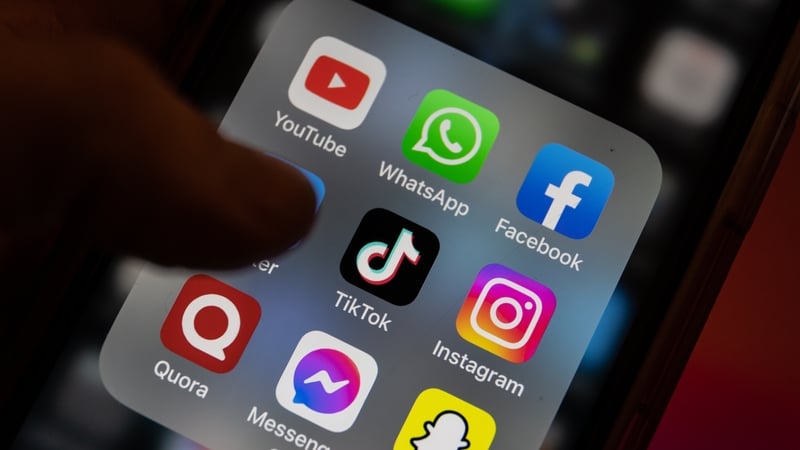Analysis: Far-right figures are using the strategies of influencer culture to spread reactionary messages and monetise their politics
Far-right political movements are on the rise in Ireland and elsewhere. Their growth is accompanied by an escalation in intimidation tactics targeting women, LGBTQIA+ community, migrants, refugees and other minorities. By drawing prejudices such as racism, misogyny, and homophobia out into the mainstream, far-right political influencers on social media play an important role in this process.
Right-wing figures have for a long time known how to turn media of various kinds to their advantage. Until relatively recently, they relied on the relationships audiences imagined themselves to have with the personalities they saw on their screens. Today, far-right commentators can draw on the strategies of influencer culture to spread reactionary messages and to seek social and political outcomes.
We need your consent to load this rte-player contentWe use rte-player to manage extra content that can set cookies on your device and collect data about your activity. Please review their details and accept them to load the content.Manage Preferences
From RTÉ One News, rise of far-right highlighted in new study on disinformation in Ireland
Rather than imagined connections, the relationships between influencers and their followers are strengthened by promoting a sense of shared intimacy. While social media influencers build their profile by creating attachments between products and lifestyles, political influencers engage with audiences by creating links to political ideas and identities. What does that look like in the context of radical right-wing politics? And why does it matter?
Making a show of yourself
Visibility forms a key part of an influencer's attempt to become relevant and grow their audience, but exactly how they make themselves visible is extremely important. Far-right activists are increasingly drawing on practices learned from YouTubers, such as viral stunts and the creation of real-world commotion, to gain online visibility and to go viral. Social media platforms are central to these strategies within the influencer ecosystem.
The result is that political influencers must adapt themselves to the features of different platforms, including their algorithms, in order to be effective. At the same time, far-right political movements are of note for the kinds of limitations they look to impose on who and what should be publicly visible, whether through attempts to ban books or the silencing of opponents. This is often achieved despite platform moderation policies that are supposed to stifle abuse and harassment.
We need your consent to load this rte-player contentWe use rte-player to manage extra content that can set cookies on your device and collect data about your activity. Please review their details and accept them to load the content.Manage Preferences
From RTÉ Radio 1's This Week, Prof Bryan Fanning from UCD School of Social Policy on the rise of the far right in Ireland
Being real
The success or failure of a political influencer rests on their ability to commercialise political content without causing their audience to switch off, but they must simultaneously work to appear authentic and relatable. A problem here is that production styles that come across as overly professional can work against the appearance of authenticity. This puts pressure on influencers to come across as off-the-cuff or unscripted.
But fostering the appearance of authenticity can also be a trap, because it sets up expectations among the audience that an influencer be consistent and transparent in their views and stances. Influencers therefore need to spend a good deal of effort appearing to be the real deal or risk losing audience support and thus influence. They also need to contend with the possibility that followers might tune into the fact that many have cycled through several public personas before settling into their niche market.
Feeding the trolls
Showing oneself to be a genuine representative or spokesperson for a group or a way of life is central to the strategies of political influencers. But reactionary far right influencers must also simultaneously prove their ability to make use of styles and conventions that are particular to right-wing media. Deliberate attempts to provoke conflict – or "trolling" – play a major role as a political strategy.
We need your consent to load this rte-player contentWe use rte-player to manage extra content that can set cookies on your device and collect data about your activity. Please review their details and accept them to load the content.Manage Preferences
From RTÉ Radio 1's Morning Ireland, Ciarán O'Connor from the Institute for Strategic Dialogue, on how far right groups are capitalising on protests in Ireland
Humour here becomes a tool for marking boundaries and for building community and common identity. But far-right influencers can also use claims of humour to disguise acts of hate speech and as a "cover" for extremism. This is risky business for a reactionary influencer. Badly judged content comes with the prospect of getting deplatformed, cutting off influencers from their audience and from revenue. However, we have seen many such influencers replatformed when a platform acquires a new owner.
Show me the money
The political influencer space exists at a strange intersection between the political and the economic. One of its key features is the extent to which an influencer can monetise both their character and their content. A segment of this commercialisation is linked to advertising spending, as well as influencers being paid to spread political messages. But influencers also increasingly rely on subscriptions and crowdfunding, helped by a variety of platforms, to achieve political goals and secure an income.
Studies of media show there's a connection between media ownership and media agendas. That’s why the notion of an independent media is seen as essential to freedom of speech. But it’s not just traditional media such as TV and radio where this applies. The new forms of media financing currently gaining traction within the influencer industry raise many questions and highlight the kinds of expectations that audiences will have about the messages the influencers they follow can and should communicate.
We need your consent to load this rte-player contentWe use rte-player to manage extra content that can set cookies on your device and collect data about your activity. Please review their details and accept them to load the content.Manage Preferences
From RTÉ Brainstorm, what's behind the rise of the far right in Irish politics?
So what's next?
The rapid and ongoing changes that define digital culture are a reminder that the current crop of reactionary influencers will at some point be replaced by newer models. The kinds of figures gaining popularity among younger audiences are a sign of where things might be going. This is meaningful, because the misogyny and antifeminism prominent among some contemporary influencers are shown to act as a gateway to other forms of prejudice, including racism and antisemitism.
As this space evolves, influencers who promote certain worldviews may find themselves aligned with others they may not be so comfortable to support. How they choose to amplify such perspectives may well be driven by the logics of an attention economy that thrives on clicks and eyeballs. Inevitably, those who amplify far-right movements will also bear responsibility for their outcomes.
The views expressed here are those of the author and do not represent or reflect the views of RTÉ


